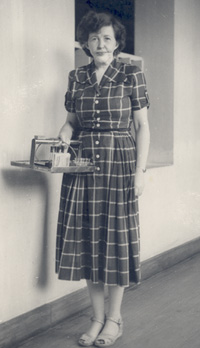Virginia Minnich (1910-1996)
Born on January 24, 1910, Virginia Minnich was raised on her family’s farm in southern Ohio. Economic conditions forced Virginia to delay starting college until 1932, when one of her older sisters was able to lend her the tuition money. She earned a bachelor’s degree in Home Economics in 1937, and a master’s degree in Nutrition from Iowa State University. During her senior year of college, Minnich worked in the lab of Dr. Carl V. Moore, who was a research fellow in the Department of Hematology at Ohio State. Two years later, when Moore was establishing a Division of Hematology in the School of Medicine, he wrote Virginia Minnich and offered her a job as technician. Minnich accepted the position and subsequently spent her entire professional career at Washington University.
Minnich was a noted teacher, training sophomore medical students, hematology fellows, house staff members, and lab technicians. As an offshoot of her teaching, Minnich developed a series of audiovisual materials on all aspects of the morphology of the peripheral blood films and bone marrow, which were used by hematologists worldwide. In the early 1980s the American Society of Clinical Pathologists published Minnich’s 10-part audio-visual course in morphologic hematology.
Her research interests were diverse, focusing on iron metabolism, vitamins, platelets, abnormal hemoglobins, pica, thalassemia, glutathione, and carcinogens. Her work led to the discovery of hemoglobin E and the elucidation of the glutathionine synthesis pathway. Minnich traveled extensively – both to scientific conferences and for pleasure. Her reputation as a teacher and accomplished morphologist led to her being asked to help establish hematology labs around the world.
In 1945 Minnich set up a lab at the University of Havana. In 1951 she went to Siriraj Hospital in Bangkok, Thailand as part of an exchange program, funded by the U.S.P.H between the hospital and Washington University. While there she taught and began her noted research on thalassemia and hemoglobinopathies. Minnich returned to Bangkok for several months in 1954 to continue her research. In 1964 Minnich received a Fullbright-Hayes fellowship to go to Turkey to establish a hematology laboratory in the Department of Pediatrics at the University of Ankara. The University later named it the Virginia Minnich Hematology Laboratory in honor of her work there. It was in Turkey that Minnich became involved in the study of pica (the habit of eating dirt). Minnich continued this research after returning to the United States, later establishing that certain types of dirt and clay interfered with the absorption of iron.
Virginia Minnich published more than 45 scientific papers and authored 19 abstracts over the course of her career. In 1974, Minnich was made a professor of Medicine, the first person to achieve that rank at Washington University with neither a medical degree nor a Ph.D. Upon her death in 1996, the Division of Hematology-Oncology established the Virginia Minnich Memorial Visiting Professorship in Hematology in her honor.

Related Resources:
Back to Biographies

